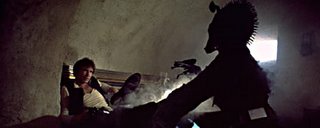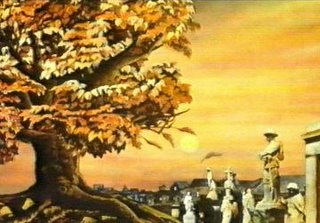Hey wha happun?
Did September just fffffft by or what? (Yes, fffffft is the correct spelling of the sound of an arrow flying by. Unless of course the arrow hits you, in which case thwack is preferred. An arrow hitting the wall just behind you is shwumph, and a kryptonite arrow caught midflight by Superman is fapp. Trust me — Ollie* and I have been spending a lot of time together lately.)
But September, huh? 'Twas just Labor Day, no? I'm looking around for hard evidence that we've actually experienced a month's passage, but all I find are leftovers of August.
Maybe it's because Maus and I lost a couple weeks to the watching of seasons 1 and 2 of House. And a full Ken Burns 9-parter. Oh yeah, and that 41-hour Danielle Steele dramathon where Martha Kent sleeps with a kindly Nazi and then grapples with a spoiled brood whose proclivities toward evil materialize through their hair...
[Channeling House: “So what accounts for temporal dissocia accompanied by heightened cravings for both reflective historo-documentia and 80s pulp-novel hair-dramatis?
 The Burns could indicate an attempt at compensatory self-medication following prolonged exposure to the Steele... except that the PBS symptoms presented before the WeTV. Hmm. OK, put him on ibubourbopraxis to suppress the medi-drama addiction long enough to get a lumbar puncture. Chase, you do it. And do an MRI while you're at it to check for growths in the hair-and-bile system. Cameron, check for lupus. It's not lupus, but check anyway. Foreman, break into this weirdo's house and get me samples of whatever he's been drinking.”]
The Burns could indicate an attempt at compensatory self-medication following prolonged exposure to the Steele... except that the PBS symptoms presented before the WeTV. Hmm. OK, put him on ibubourbopraxis to suppress the medi-drama addiction long enough to get a lumbar puncture. Chase, you do it. And do an MRI while you're at it to check for growths in the hair-and-bile system. Cameron, check for lupus. It's not lupus, but check anyway. Foreman, break into this weirdo's house and get me samples of whatever he's been drinking.”]Actually, I'd like to think the fffffft sensation has more to do with a new writing project that's been eating up my non-TV hours, such as they are. No details just yet. Suffice to say that it will require the watching and rewatching of a lot of old movies.
Hope my weakened system can handle it.
*Ollie's going to appear as a recurring character on Smallville this season — in at least 5 episodes. My natural enthusiasm for this news is tempered somewhat by the memory of the beefy horror of last season's Aquaman cameo.









